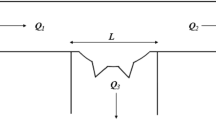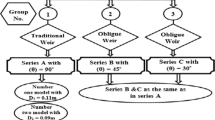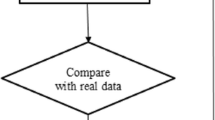Abstract
In this paper, the coefficient of discharge was calculated using Artificial Neural Network (ANN) for two triangular side weir models installed with flow direction and opposite to it. These values compared with that which calculated empirically using Rehbock formula, the variables affecting on this equation where found and analysis using Buckingham (pi-theory) to reduce to minimum variables affecting in side weir flow, the results shown that agreement between empirical method and that calculated using (ANN) with (MSE = 0.00113) and (R = 0.982).








Similar content being viewed by others

Abbreviations
- ANN:
-
Artificial Neural Network
- b :
-
Width of branch channel (L)
- B :
-
Width of main channel (L)
- C d :
-
Discharge coefficient of side weir
- C dn :
-
Discharge coefficient calculated by (ANN)
- FFANN:
-
Feed Forward Artificial Neural Network
- Fr :
-
Froude number
- g :
-
Acceleration due to gravity (L/T2)
- h :
-
Water height over side weir crest (L)
- H :
-
Water height upstream standard weir (L)
- l :
-
Length of side weir crest (L)
- MLP:
-
Multilayer perceptron neural network
- MSE:
-
Mean square error
- P :
-
Weir height (L)
- q :
-
Branch channel discharge (L3/T)
- Q :
-
Main channel discharge (L3/T)
- Q th :
-
Theoretical discharge in branch channel (L3/T)
- Q TO :
-
Total discharge (L3/T)
- R :
-
Correlation coefficient
- RBF:
-
Radial basis formula neural network
- Re :
-
Reynolds number
- We :
-
Webber number
- y :
-
Normal water depth in the main channel (L)
- θ :
-
Apex angle of side weir
- ρ :
-
Density of water (M/L3)
- σ :
-
Surface tension (M/T2)
- µ :
-
Viscosity of water (M/L T)
Reference
Abbas P, Amir HH. Prediction of side weir discharge coefficient by radial basis function neural network. MOJ Civil Eng. 2018;4(2):93–8.
Ahmed YM, Azza NA-T, Talal AB. Simulation of Flow Over The Side Weir Using Simulink 08/2013. Scientia Iranica. 2013;20(4):1094–100.
Ahmed YM. Theoretical analysis of flow over the side weir using Runge Kutta method. Ann Fac Eng Hunedoara Int J Eng Ix. 2011;2:47–50.
Ahmed YM. Numerical analysis of flow over side weir. J King Saud Univ Eng Sci. 2015;27:37–42. https://doi.org/10.1016/j.jksues.2013.03.004.
AL-Omari NK (2011) Laboratory Study of the Effect of the Branching Angle and the Branching Channel Slope on Flow. M.Sc. water resources engineering ,Mosul university, Iraq
Azza NA-T. Flow Over Oblique Side weir. Damascus Univ J. 2012;28(1):5–22.
Fausett L (1994) Fundamental of neural networks algorithms and applications. Prentice Hall in Snc
Gania H, Azza A-T, Mena A-S. Coefficient of discharge for labyrinthine side weir. AL Rafdain Eng J. 2012;20(4):38–49.
Hana H, Mina A-S, Azza A-T (2012) Characteristics of flow over long sharp crested weir. In: First international conference in water resources engineering, College Of Engineering, University Of Technology, pp 33–40
Hana H, Mina A-S, Azza A-T (2014) Study of Water Surface Profile for Different Shapes of Side Weir. ANNALS OF FACULTY ENGINEERING HUNEDOARA. Int J Eng, Tome XII (2014). Fascicule 4, 245–254
Hazi MA, Amir HH, Abbas P. Prediction of side weir discharge coefficient by support vector machine technique. Water Sci Technol Water Supply. 2016;16(4):1002–16.
Hossein B, Amir HZ. New type side weir discharge coefficient simulation using three novel hybrid adaptive neuro-fuzzy inference systems. Appl Water Sci. 2018;8(10):1–15.
Mwafaq YM, Ahmed YM. Discharge coefficient for an inclined side weir crest using a constant energy approach. Flow Meas Instrum. 2011;22(6):495–9.
Author information
Authors and Affiliations
Corresponding author
Additional information
Publisher's Note
Springer Nature remains neutral with regard to jurisdictional claims in published maps and institutional affiliations.
Rights and permissions
About this article
Cite this article
Hayawi, H.A., Al-Talib, A.N. & Kattab, N.I. Triangular Side Weir Discharge Coefficient Calculation and Comparison Using ANN. INAE Lett 4, 59–63 (2019). https://doi.org/10.1007/s41403-019-00066-w
Received:
Accepted:
Published:
Issue Date:
DOI: https://doi.org/10.1007/s41403-019-00066-w



